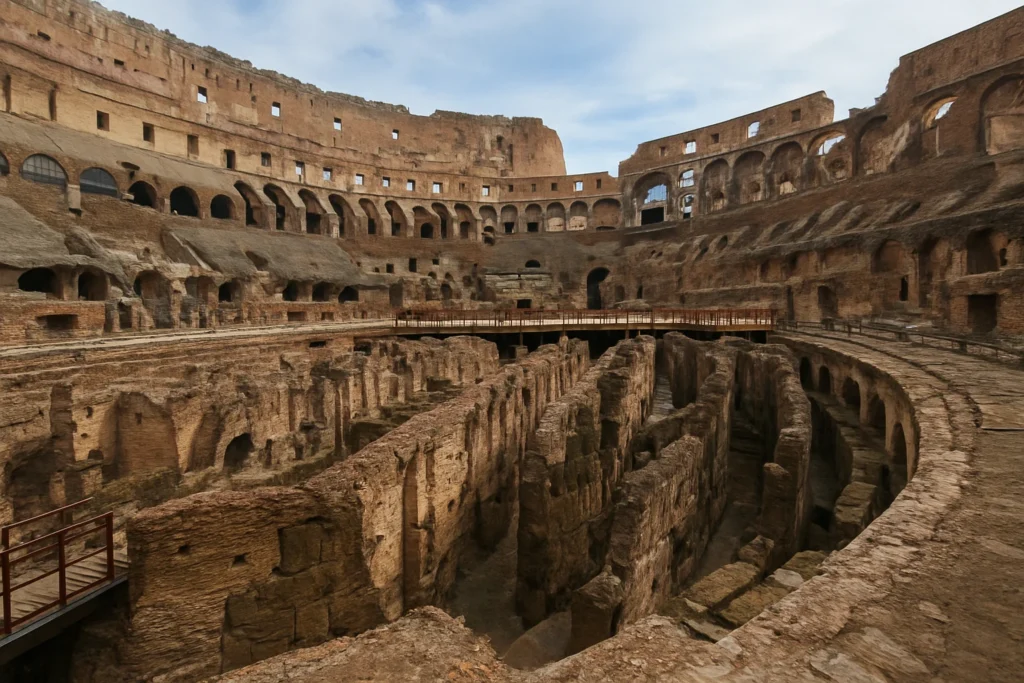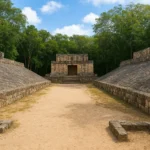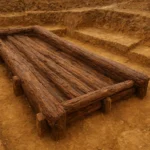Introduction: Unearthing the Colosseum’s Hidden Depths
The morning sun casts long shadows across the weathered stones of the Colosseum as archaeologists brush away centuries of dust from a newly uncovered inscription. “Marcus Antonius fought here” it reads – a silent testimony from a gladiator who perished in this arena nearly two millennia ago. This poignant discovery is just one of countless revelations emerging from the most ambitious restoration project in the Colosseum’s modern history – the complete excavation and conservation of its underground labyrinth. This monumental effort is not merely an architectural achievement; it is a profound act of archaeological resurrection.
For fourteen painstaking years, Italian authorities, aided by a global team of experts, have finally unveiled the fully restored hypogeum, the Colosseum’s vast subterranean network that served as the beating heart of ancient Rome’s most infamous spectacles. This €25 million endeavor, an undertaking of staggering complexity, has peeled back layer after layer of history, exposing the complex machinery and human drama that made the arena’s deadly games possible. For the first time since the fall of the Roman Empire, visitors can walk through the same shadowy passageways where gladiators prepared for battle and exotic animals from across the empire awaited their grim fate.
The restoration represents far more than a simple feat of engineering. It offers us an unprecedented window into the daily operations of the ancient world’s most sophisticated killing machine – a place where technological brilliance and human brutality existed side by side. As we descend into these newly accessible depths, we don’t just see ancient stones; we confront the very essence of Roman society – its technological prowess, its insatiable thirst for entertainment, and its casual, yet profound, acceptance of violence as public spectacle. The hypogeum, now fully revealed, allows us to step back in time and confront the full, unvarnished truth of the Colosseum’s legacy.
Chapter 1: The Hypogeum – Masterpiece of Roman Engineering
The Underground City Beneath the Arena
The hypogeum (from the Greek for “underground”) was nothing short of an architectural marvel—a sprawling subterranean complex covering nearly two acres beneath the arena floor. It was a world of perpetual twilight, a living, breathing machine that operated with military precision, allowing the Romans to stage increasingly elaborate spectacles that blended violence, mythology, and theatricality. The Colosseum’s exterior may have been a facade of grandeur, but its true power lay in the intricate labyrinth below. This was the beating heart of the games, the logistical engine that turned blood and sand into a grand theatrical performance.
Recent laser scans and meticulous archaeological mapping have revealed the hypogeum’s true scale and complexity:
- Over 160 passageways radiating outward like spokes on a wheel, creating a bewildering maze designed for efficient movement and crowd control. Each tunnel served a specific purpose, from housing animals to moving props and combatants.
- 80 vertical shafts equipped with primitive, human-powered elevators. These were not just for convenience; they were central to the drama, allowing beasts and fighters to make sudden, terrifying appearances on the arena floor.
- 24 trapdoors were strategically embedded in the arena floor, designed for sudden, dramatic reveals. They were the equivalent of a modern stage’s trapdoors, transforming the spectacle from a simple fight into a dynamic, unpredictable performance.
- 3 main corridors ran the entire length of the arena, serving as the primary arteries of the hypogeum, connecting the various animal pens, staging areas, and barracks.
The Machinery of Death and Theatricality
At the heart of the hypogeum’s design was an ingenious system of pulleys, counterweights, and capstans. This was a vast, silent machine of wood and rope, operated by the sheer brute force of enslaved labor. It was capable of feats that seem almost miraculous for the ancient world:
- Lifting 900-pound animals to the arena floor in a matter of seconds. Imagine the sheer strength required from the teams of slaves turning the massive windlasses to hoist a roaring lion from the darkness into the blinding sun.
- Deploying elaborate stage sets for mythological reenactments. The hypogeum could be transformed to resemble a forest, a rocky landscape, or even a fantastical realm, all for a fleeting performance of a Greek myth or a historical battle.
- Creating sudden appearances of combatants or beasts from below the surface. This element of surprise was a favorite of the Roman audiences and a terrifying reality for those in the arena.
Archaeologists have identified the remains of 15 different elevator systems, each operated by teams of slaves turning massive windlasses. The largest of these could hoist a full-grown bull elephant to the surface—a terrifying spectacle that Roman audiences adored, and a profound testament to the power of human labor and ingenuity. The precision of this system was a marvel, a perfectly choreographed dance of danger.
Water Management in the Depths
Perhaps one of the most underrated aspects of the hypogeum’s engineering was its advanced drainage and water management system. While the early Colosseum was once flooded for mock naval battles (a practice discontinued after the hypogeum’s construction), the subterranean levels required sophisticated hydraulic engineering to remain functional. The system featured:
- Lead pipes that fed fresh water to animal pens for drinking and cooling, a small luxury in this otherwise brutal environment.
- Sloped floors and channels meticulously designed to funnel away blood, waste, and rainwater, preventing the hypogeum from becoming a fetid swamp.
- Ceramic gutters prevented flooding during torrential rains, a constant threat in the Italian climate.
This system was so effective that modern engineers have incorporated similar designs into contemporary stadiums, proving the Romans’ hydraulic expertise remains remarkably relevant nearly 2,000 years later. It underscores that Roman genius was not just for grand public works but for the practical, invisible details that made their civilization function.
Chapter 2: Life (and Death) in the Underground
The Gladiators’ Last Hours
Walking through the newly restored gladiator chambers, one can almost hear the faint clank of armor and the murmured prayers of condemned men. These cramped, claustrophobic cells, none larger than four square meters, housed fighters in their final, tense hours before combat. This was the place where hope and despair met, where a gladiator’s life flashed before his eyes before his final walk into the light. Recent findings have made these human stories tangible:
- Personal graffiti scrawled on the walls offers a direct link to the men who once stood there. “Celadus the Thracian makes the girls sigh,” boasts one inscription, a poignant mix of bravado and youthful longing for fame.
- Gambling dice carved from bone have been found, suggesting that even in the face of death, men still sought a moment of distraction or a small thrill.
- Medical instruments used for last-minute treatments speak to the brutal reality of their lives—a constant cycle of injury and patched-up recovery.
Forensic analysis of the walls reveals fascinating, heartbreaking details:
- Fingernail scratches near doorways suggest the palpable anxiety and desperation of men awaiting their fate.
- Charcoal marks may indicate daily tallies of fights or even a simple calendar, a way to mark the passage of time in this sunless world.
- Oxidized metal stains from chains and weapons serve as silent, corroded reminders of the bonds that held them and the weapons that would seal their destiny.
The Animal Keepers’ Grim Duty
The eastern sector of the hypogeum housed the bestiarii, the animal keepers who managed hundreds of exotic animals. Theirs was a dangerous and thankless job, living in close proximity to the unpredictable beasts of the empire. Excavations in this area uncovered:
- Iron-reinforced cages with deep gnaw marks, a terrifying sign of the wildness they contained.
- Feeding troughs containing remnants of exotic diets, a testament to the complex supply chain required to sustain this menagerie of terror.
- Training whips with embedded metal spikes, cruel tools used to control and subdue the powerful animals.
Records show some of these animals became celebrities in their own right, their names known to the Roman public:
- The lion “Victor,” who became legendary for defeating 12 men in a single venatio.
- “Tigris” the man-eater, a fearsome beast from Mesopotamia whose reputation alone drew enormous crowds.
- “Crassus” the armored bear from Germania, whose thick fur and immense strength made him a fearsome, and highly sought-after, combatant.
The Stagehands’ Invisible Labor
An army of slaves, perhaps 300-500 strong on any given day, operated the hypogeum’s machinery. Theirs was an invisible labor, a world of shouting, sweating, and sheer exertion that the audience above never saw. New evidence suggests an incredibly sophisticated system for managing this human workforce:
- Color-coded tunnels guided workers to their specific stations (red for animals, black for prisoners), ensuring order and speed in the chaos.
- Acoustic tubes running through the walls allowed shouted commands to travel instantly between sections, a primitive but effective form of communication.
- Rotation systems were implemented to prevent workers from learning the full layout, a security measure to prevent escape.
Their working conditions were brutal and unforgiving:
- 16-hour shifts were common during games, with no breaks.
- Deaths from machinery accidents were a frequent occurrence, a grim but expected part of the job.
- Whipping posts found near work stations serve as a stark reminder of the harsh discipline that governed their lives.
Chapter 3: The Restoration – A Feat of Modern Archaeology
Decades of Challenges
The hypogeum had suffered greatly over the centuries, a victim of both natural disaster and human neglect:
- Medieval lime burners looted the Colosseum’s marble and stone for mortar, turning a monument into a quarry and causing irreparable damage.
- Earthquakes in 443 AD and 1349 caused large-scale collapses, burying entire sections of the underground network.
- Sewage infiltration during the Renaissance and later periods created a polluted, unstable environment that threatened the remaining structures.
Initial 19th-century excavations, while groundbreaking, actually caused more damage than they repaired:
- Improper shoring led to new collapses, burying previously uncovered areas.
- Early concrete repairs trapped moisture, accelerating the decay of the original stonework.
- Victorian treasure hunters, more concerned with relics than history, destroyed fragile stratigraphy, making it harder for modern archaeologists to understand the site’s timeline.
21st Century Breakthroughs
The current project employed revolutionary, non-invasive techniques that represent the very best of modern archaeology:
- LIDAR mapping created millimeter-accurate 3D models of the entire complex, allowing archaeologists to study the hypogeum in virtual space before ever setting foot in a fragile area.
- Microbial analysis of the remaining mortar identified the original Roman recipes, allowing restorers to create historically accurate, durable materials for repair.
- Drone inspections with high-resolution cameras accessed unstable and dangerous areas, providing crucial data without risking human life.
- AI-assisted imaging and infrared photography reconstructed faded frescoes and inscriptions that were invisible to the naked eye.
These techniques led to astonishing discoveries:
- A gladiator’s leather pouch containing a few coins and a lucky charm carved from bone, a deeply personal find that humanizes the past.
- An intact wooden elevator platform, miraculously preserved after being carbon dated to 90 AD, offering a tangible link to the incredible machinery.
- A surgeon’s kit with 42 bronze instruments, revealing the medical care available to gladiators and the brutal nature of their injuries.
Preservation for the Future
The restoration team implemented cutting-edge conservation techniques to ensure the hypogeum’s survival for centuries to come:
- Nano-particle coatings were applied to stone to protect it from atmospheric pollution and acid rain.
- Climate-controlled walkways and strategic ventilation systems were installed to maintain ideal humidity and temperature, preventing further decay.
- Smart lighting was used to illuminate the tunnels with minimal heat output, reducing damage to fragile stone.
- Vibration sensors were embedded throughout the structure to monitor its integrity and provide early warnings of any instability.
Chapter 4: Visiting the Restored Hypogeum – A Traveler’s Guide
The New Visitor Experience
The restored hypogeum offers an unparalleled level of access and immersion:
- Walk the original service tunnels used by slaves and stagehands, feeling the weight of history under your feet.
- Stand in a reconstructed animal cage as a demonstration of the door mechanism is performed, providing a terrifying sense of the beasts’ final moments.
- Operate a replica elevator using Roman techniques, a hands-on experience that reveals the immense physical labor required.
- View the arena floor from a gladiator’s perspective, looking up at the sunlight and the roaring crowds.
Special programs have been designed to enhance the experience:
- Night tours by torchlight (limited to 25 visitors) offer a haunting and intimate look at the hypogeum, stripping away the daytime crowds and allowing the imagination to fill the silence.
- Gladiator training workshops using replica gear provide a small taste of the fighters’ physical discipline.
- Archaeologist-led deep dives allow visitors to learn about the newest findings directly from the experts who uncovered them.
Virtual Reality Reconstructions
For those who cannot visit in person, technology has created new ways to explore:
- 360-degree interactive tours show the hypogeum in its prime, with the tunnels bustling with activity and the elevators hoisting animals.
- Augmented reality apps overlay ancient scenes on the current ruins, allowing you to see what the tunnels once looked like on your smartphone screen.
- Digital recreations of key moments, like the operation of the elevators, are available online for anyone to see.
Visitor Tips
To fully appreciate this once-in-a-lifetime experience:
- Read about gladiators and Roman engineering beforehand to understand the context.
- Wear sturdy, comfortable shoes as the floors are uneven and a lot of walking is involved.
- Bring a small flashlight to see the intricate details and inscriptions on the walls.
- Visit early in the morning or during the off-season for the smallest crowds.
- Hire a specialist guide for deeper insights into the stories and history of the hypogeum.
Chapter 5: The Hypogeum’s Legacy – From Ancient Rome to Modern Times
Influence on Modern Architecture
The genius of the Colosseum’s design is still evident today, influencing modern structures in ways we might not realize:
- Sports stadiums with retractable roofs and complex logistical systems for teams and fans.
- Concert venues and theaters with elaborate trapdoor systems and stage setups for theatrical reveals.
- Theme park rides that use timed reveals and hidden mechanisms to create a sense of surprise.
- Military training facilities with obstacle courses and complex layouts for strategic training.
Ethical Questions Raised
The restoration of the hypogeum forces us to confront difficult ethical questions about human nature:
- The normalization of violence as entertainment, a theme as relevant today as it was in ancient Rome.
- The exploitation of humans and animals for spectacle and profit.
- The parallels between Roman circuses and modern sports and media, forcing us to examine our own consumption of entertainment.
- The responsibilities that come with preserving dark history, ensuring it serves as a lesson rather than a glorification.
Ongoing Mysteries
Despite the restoration, some puzzles remain, preserving an element of mystery:
- Where exactly did the emperor’s private entrance and underground box lead?
- How were aquatic battles (naumachiae) staged in the early days of the Colosseum before the hypogeum was built? The mystery of this transition remains a subject of intense debate.
- What happened to the hypogeum’s missing central shrine, which was likely dedicated to a Roman god?
- Are there still undiscovered chambers or tunnels that were deliberately sealed off?
Conclusion: Walking With Ghosts of the Arena
As you emerge from the hypogeum’s shadowy depths into the sunlight, the weight of history lingers. The restored underground isn’t just an archaeological site—it’s a profound, visceral bridge to understanding how an entire civilization could watch extraordinary violence with cheers rather than horror. It challenges us to consider what forms of entertainment we accept today that future generations might view with similar dismay.
The stones whisper stories if we listen carefully—of the Thracian gladiator who won his freedom after 13 victories, of the African lion that refused to attack a kneeling prisoner, of the anonymous slave who maintained the elevators that made the spectacles possible. Their world, now made tangible again through this remarkable restoration, reminds us that humanity’s capacity for both cruelty and ingenuity remains unchanged across the centuries. It is a powerful lesson in a place where history feels not like a distant memory, but a living, breathing presence.
Practical Information for Visitors:
- Official Website: Parco Colosseo
- Ticket Reservations: Required for hypogeum access and sell out quickly.
- Best Time to Visit: November-February for smaller crowds and more serene tours.
As the ancient Roman poet Juvenal once observed, “Two things only the people desire – bread and circuses.” The restored hypogeum stands as a powerful testament to that enduring truth, inviting us to reflect on the spectacles we create and consume in our own era, and to never forget the hidden costs of our entertainment.




3g8r3o